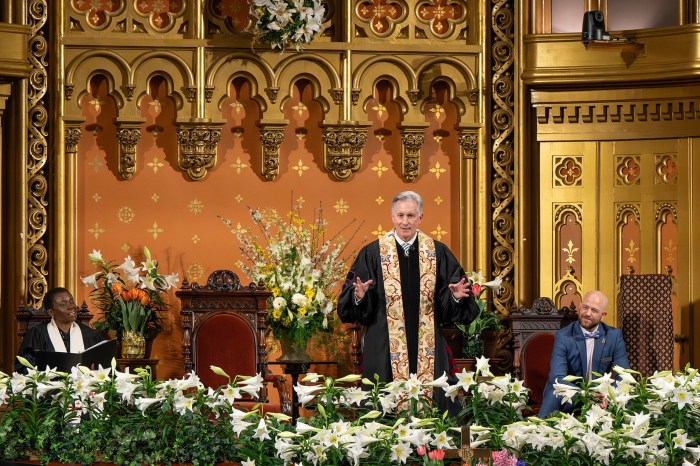
BY JACKSON CHEN | Following numerous requests for improved safety for Upper West Side cyclists, the city’s Department of Transportation has proposed a protected bike lane on Amsterdam Avenue that won praise from many neighborhood residents.
Community Board 7’s November 10 Transportation Committee meeting drew a packed crowd that welcomed the proposal with long, hearty applause after the presentation concluded and the floor was opened up for questions.
DOT Commissioner Polly Trottenberg said there hasn’t been a street in the city she’s heard more about than Amsterdam Avenue, which she described as an “important artery” of the Upper West Side neighborhood.
The DOT proposal, which calls for the creation of a protected northbound bicycle lane on Amsterdam, would reconfigure the current setup of four lanes dedicated to through traffic and two for parking.
According to the DOT’s presentation, the new layout would include three through traffic lanes, a retooling of the existing parking lanes, and a new six-foot bicycle lane with a five-foot buffer.
Many area cyclists showed their support for what they see as a much-needed proposal, given that there is a successful southbound protected bike lane on Columbus Avenue, but no similar northbound option.
“What Columbus has, Amsterdam needs,” said Celine Armstrong, a frequent cyclist in the Upper West Side area. “Right now on Amsterdam, there isn’t the perception of safety.”
Armstrong said she was recently hit by a motorist who was trying to parallel park, adding that the incident never would have happened on Columbus Avenue.
“Due to double parked cars and loading trucks, bikers need to go around and merge with lanes with speeding taxis,” said Avner May about biking on Amsterdam Avenue. “All of which is a hazardous experience.”
May, an Amsterdam Avenue resident who used to bike to his classes at Columbia University, described the avenue as an incredibly scary place to bike. After being hit by a city bus biking along the nearby 97th Street Transverse through Central Park, May made a personal decision to avoid problem areas and not bike northbound on Amsterdam — opting to walk to class instead.
Joining May, many other residents shared their own accounts of being hit, knowing of someone who was hit, and the general unsafe atmosphere they perceive on the avenue. Supplementing these anecdotal accounts, the DOT shared data that showed 513 injuries, 36 severe injuries, and two fatalities from 2009 to 2013 on the stretch of Amsterdam Avenue from West 72nd Street to West 110th Street.
Additionally, the DOT presented statistics on the impact of the Citi Bike program since its introduction on the Upper West Side, which showed an increase in the frequency of bikes using Amsterdam Avenue nearly tripling, from 217 for a 12-hour stretch in 2007 to 609 in 2015. On top of the swell of bicycles in the area, DOT officials said that the avenue’s existing issues also include drivers speeding 59 percent of the time during off-peak hours, crosswalks with unusually long spans, and high congestion generally.
“Today, Amsterdam Avenue is based on a design that is at least a half-century old,” said City Councilmember Mark Levine, whose district covers a portion of the Upper West Side. “In order to make this thoroughfare safer for all — motorists, cyclists, and pedestrians — we need to modernize it.”
While the DOT has a preference for Amsterdam Avenue as the neighborhood’s northbound bike lane corridor, the agency has also studied other options, including using Broadway or converting the Columbus Avenue protected bike lane into a two-way route.
Even if the agency decides to go with another avenue, Amsterdam Avenue would still see the pedestrian and parking improvements that are part of the current proposal.
According to DOT, Amsterdam Avenue’s west side parking lane would be converted into a combination of left-turn bays and pedestrian islands. The reconfiguration would result in a 25 percent loss of parking spaces, the agency acknowledged.
As for the east curb on Amsterdam Avenue, the current one-hour metered parking regulation would convert into a 7 a.m. to 7 p.m. commercial lane for delivery trucks. According to the DOT, the commercial parking regulations would reduce the likelihood of trucks double-parking and provide them with a space dedicated for their loading and unloading.
Despite widespread support, some voices of opposition were present in the crowd. According to Gary Greengrass, a business owner on Amsterdam Avenue, the proposal would reduce parking spaces for customers. Cyclists and their bike lanes, he said, can be dangerous for pedestrians and the new proposal would create traffic congestion.
“Amsterdam is a main thoroughfare, restricting it is going to create more of a bottleneck,” Greengrass said. “Traffic comes to a standstill on Columbus. It’s going to be the same for Amsterdam.”
Most of the board’s Transportation Committee members, however, seemed to be in support of the initial presentation. After reviewing the proposal, the committee had questions about its impact on local businesses, the viability of Central Park West as a bike route, and if there could be any interim safety improvements done before implementation of the plan. DOT officials said Central Park West was too narrow to accommodate a protected bike lane.
According to Sean Quinn, co-director of the DOT’s Pedestrian Projects Group, the “biggest bang for the buck” would be to tackle this Amsterdam Avenue project as soon as possible.
After gathering community input, the DOT is expecting to start the first phase of the project as early as Spring 2016. During its implementation of the first phase — from West 72nd Street to West 110th Street — the city agency will also be looking toward the second phase of the Amsterdam project, which involves bicycle connections south of West 72nd Street.
“I hope this is one part of a really much larger project to make the city, as a whole, a safer place for bikers as well as pedestrians, really anyone for that matter,” May said. “It really is a matter of lives and limbs.”




































